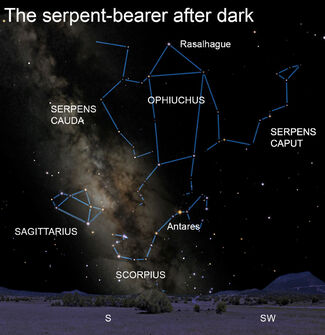Ophiuchus, the Serpent-Bearer
Last updated 8/19/2022 at 9:07am

The stars of Serpens are entwined with those of Ophiuchus, which is believed to represent Asclepius, the ancient Greek god of health and healing. Its brightest star is named Rasalhague which, appropriately, is Arabic for "Head of the Snake Charmer." And Serpens – the only two-part constellation in the heavens with its head on one side (Serpens Caput) and its tail on the other (Serpens Cauda) – is draped across the front of his body.
Even beginning skywatchers can go outdoors on a clear night and easily find among the stars the classic shapes of Scorpius, the scorpion, and the teapot of Sagittarius.
Right now, you can see them both low in the southern sky after dark. Scorpius is tough to miss. Its bright reddish-orange star Antares marks the heart of the celestial arachnid; above it, we can trace its claws, and below it its long, curving tail. Finding an archer among the stars of Sagittarius is a bit tougher, but if you trace its bright stars into the shape of an old-fashioned teapot, it's much easier to recognize.
Just above Scorpius and Sagittarius lies another pair of constellations that novice stargazers often ignore. These are the constellations of Serpens, the serpent, and Ophiuchus, the serpent-bearer. It admittedly takes quite some imagination to find them, but once you do, you'll know them forever.
The stars of Serpens are entwined with those of Ophiuchus, which is believed to represent Asclepius, the ancient Greek god of health and healing. Its brightest star is named Rasalhague which, appropriately, is Arabic for "Head of the Snake Charmer." And Serpens – the only two-part constellation in the heavens with its head on one side (Serpens Caput) and its tail on the other (Serpens Cauda) – is draped across the front of his body.
The serpent has long been associated with medicine, and the ancient constellation of Serpens was considered a symbol of healing. Even today, we see its form as a symbol of the medical profession. Anyone who's ever looked up the name of a physician or hospital has undoubtedly seen the symbol: two serpents wrapped around a vertical staff that is topped by a round knob and flanked by wings. It's known as the "caduceus" and, since 1902 when the U.S. Army adopted it as the insignia of its Medical Corps, has been the emblem of the American medical profession.
Many medical associations – including the World Health Organization – use what some consider the "correct" and traditional symbol of medicine: the staff of Asclepius, with a single serpent encircling it.
Ophiuchus lies among some of the thickest star clouds of the Milky Way. If you have a sky that's unpolluted by lights from a large city – or can drive to a remote dark sky site – you'll have no trouble finding the hazy band of the Milky Way passing through it.
Scan your eyes along the Milky Way and you'll be sure to spot many "faint fuzzies" (as amateur astronomers affectionately call them). Aim binoculars or a small telescope in their directions and you'll discover that many of these are star clusters or nebulae. But you should do this soon because, by early August, the moon will return to the early evening sky and its light will blot out all but the very brightest of celestial objects.
Though Ophiuchus is not one of the 12 zodiacal constellations, the sun passes through this constellation on its annual journey around the heavens. In fact, the sun spends three times as many days in Ophiuchus as it does in Scorpius. But this is a story for later in the year!



